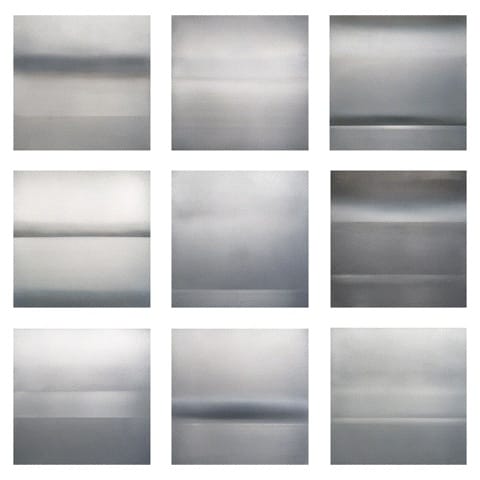What is your spiritual practice, and how does it inform your work?
I was raised in a Nichiren Temple and studied the Lotus Sutra, so those are the traditions at the foundation of my belief system. In the past several years I’ve become more interested in Zen, particularly in terms of the connection between Zen and Reductivism in artwork. Reductivism is about paring down to the essentials, a simplification and streamlining in thought and execution of artwork. In Zen temples, there is a very similar ethos of removing all that is not totally necessary. There is a poignancy in this, a focus on what is left.
I approach my studio practice as a spiritual one, a walking meditation of sorts—a practice of total concentration on a physical task. Conceptually, my works are studies in nothingness and are highly informed by both my upbringing and personal religious pursuits. Lately, I have been very interested in the expression of spirituality in a more universal format, works that inspire tranquility and introspection, meditation and transcendence, in any spiritual setting.
What is the importance of lineage on the people we become? Do you think you had a natural affinity toward working with metals?
The importance of lineage varies on an individual basis, but I draw strength and meaning from my heritage. My art practice incorporates elements from my Japanese family (Buddhism and sword making) and provides a vehicle for honoring my past and expressing my beliefs. I felt an affinity with steel from the very moment I begun working with it. That said, working with metals is a continuous learning process. Even after more than a decade working with steel, I’m just starting to get a feel for the material. It will be a lifetime of study.
Do you worry about the art community’s ability to flourish in difficult economic times?
Art is something we all look to for answers, to express that which is difficult to express—peace, harmony, solace—especially in troubled times. The art community is still flourishing, though the growth may not be financial. This period of difficulty can be a time for the art community to refocus on what is most important, look inward, and therefore evolve in positive ways. In effect, a time of streamlining. For artists, I think a period of time where their works are not as commodified is a good time to be in the studio and create freely.
What was it like to go back and forth between Japan and California, dramatically different cultures?
There is a very similar peacefulness that comes with living in the foggy redwoods in Northern California and looking out at quiet rice fields outside our temple in Japan. Living between two cultures has allowed me to understand that there are many ways in this world. The Buddhism I was exposed to as a small child has been a root grounding me in whichever culture or place I find myself.
How should a spectator interact with your works? What impression do you want to leave on them?
View my works at your own pace. I am cognizant of creating works which are subtle and understated and will fit with any surroundings, reflecting the environs. It is my intention to make sincere works. I hope viewers are left with a sense of serenity and further understanding. There is a concept in Japanese tea ceremony that I admire very much; it is “harmony, respect, purity, tranquility.”
